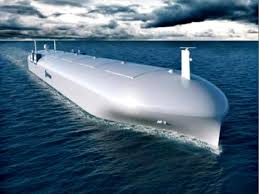It’s been a fact for decades that as commercial vessels get bigger, crews get smaller – a trend driven by both technology and economics.
But if futurists in the maritime industry are right, the next leap forward is coming, and it will cut crew size even further.
“We are now at the dawn here of a ship intelligence era…It’s coming. It’s coming quickly,” Oskar Levander, vice president of marine innovation for Rolls-Royce autonomous ship concept. Image courtesy Rolls-Royce.Rolls-Royce, told an audience at the Society of Naval Architects and Maritime Engineers’ World Maritime Technology Conference 2015 in Providence, R.I.
Information technology will make it easier and safer to operate autonomous vessels, and the revolution could start in workboats, like ferries and offshore service vessels, Levander said. It will not totally eliminate the jobs of human mariners – there will still be a need for captains, mechanics and other critical monitoring and maintenance duties.
But, it is about “utilizing ship intelligence to reduce crew,” said Levander, whose company has conceptualized automated and remotely piloted vessels with a $7 million investment. And that means lower building and operating costs: “Altogether, we can simplify the ship.”
There were skeptics in the SNAME crowd. For bluewater cargo, flag of convenience operators might pay just $1,500 a day to keep 10 more seamen on board, so savings might be over-estimated, one said.
The question of bridge automation in passenger service came up when William Burke, a retired U.S. Navy vice admiral and now chief maritime officer for Carnival Cruise Lines, gave his talk on the company’s officer training program. Burke did not need long to answer.
“I don’t see how you put thousands of people in an unmanned situation,” he said. Undermanning has been a bone of contention between maritime management and labor forever.
In the 19th century, high-profile accidents linked to short crews led to government intervention. Even in the 21st century offshore wind industry, it can be an issue for operators in European waters.
Levander contends more automation will in fact improve safety, lessening chances for human error – and human casualties. He asked: Is it not better to have pilots operate a drone OSV through a storm from the safety of an office onshore?
Technically, Levander said, one day it may even be possible to engineer a self-docking vessel, a bigger version of the self-parking car Google engineers are working on. Meanwhile, looks around the room said: “Yeah, but Google’s parking lot isn’t moving.
“So much of what tugboats do is by feel and experience,” said Dave Weathers, inland waters vice president for the American Maritime Officers.
Even if an autonomous ship can guide itself to port, realities of legal responsibility and public confidence will still most likely demand human captains and pilots, Levander said.
In this most conservative of industries, the insurance companies will have something to say about autonomous ships. Then too, “it will be a long time before the regulatory bodies sign off,” Weathers said.




